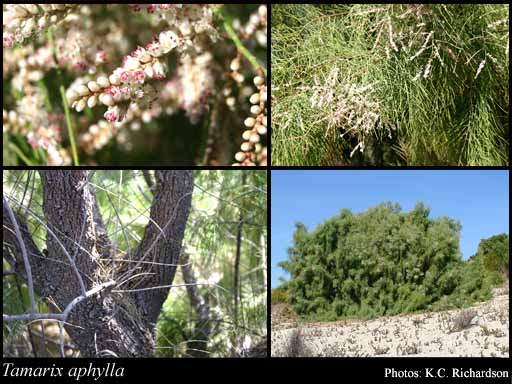- Reference
- Deut.Fl. 641 (1882)
- Conservation Code
- Not threatened
- Naturalised Status
- Alien to Western Australia
- Name Status
- Current
Tree, to 12 m high. Fl. pink-white, Feb or May. Along river banks.

Distribution
- IBRA Regions
- Avon Wheatbelt, Carnarvon, Central Kimberley, Geraldton Sandplains, Mallee, Pilbara, Swan Coastal Plain.
- IBRA Subregions
- Cape Range, Geraldton Hills, Hamersley, Hart, Katanning, Perth, Western Mallee, Wooramel.
- IMCRA Regions
- Central West Coast.
- Local Government Areas (LGAs)
- Ashburton, Beverley, Carnarvon, Cockburn, Exmouth, Greater Geraldton, Halls Creek, Kulin, Rockingham, Shark Bay, South Perth, Toodyay, Wanneroo.
Management Notes (for the Swan NRM Region)
Common Names. Athel Pine, Athel Tamarisk, Flowering Cypress, Salt Cedar
Synonyms. Thuja aphylla L.
Classification. Weed of National Significance (WoNS) and Declared Pest in Western Australia. Check legal status in the Western Australian Organism List.
General Biology. Growth form. Tree. Life form. Perennial. Reproduction. Seed and vegetative growth. Dispersal. Wind, water, and machinery. Time to first flowering. Three years. Seedbank persistence. Short, up to a few weeks (longer if dry). Fire response. Resprouts from root-crown after fire.
Notes. Athel Pine displaces Eucalyptus species and other native vegetation, resulting in dominance of the ground vegetation. Its’ leaves excrete salts which lead to higher salinity in leaf litter, and it may alter fire regimes as it does not burn well. Seedlings develop rapidly once established, forming a strong woody root system. Well suited to arid and semi-arid rangelands, it is tolerant of saline and alkaline soils but tends to flourish in and around rivers.
Additional information. Origin. Native of arid and semi-arid northern Africa and western and southern Asia. History of use/introduction. Introduced to Australia in the 1930s where it was first planted at Whyalla and Broken Hill, then widely planted across arid Australia as a shade and windbreak tree. Similar exotic species. Tamarisk (Tamarix ramosissima) and Small Flower Tamarisk (Tamarix parviflora). Similar native species. Resembles native She-oaks, Casuarina spp., and Allocasuarina spp.
Suggested method of management and control. Physical removal of seedlings and small trees (<2 m), remove as much of the root system as possible. Suitable natives should be sown in place to outcompete any potential regrowth. Chemical control may be suitable in areas susceptible to erosion. Herbicide application by frilling, cut stump, or basal bark methods on trees greater than 2 m tall. Follow-up control will be required to treat plants that survive initial treatment as athel pine readily reshoots from vegetative material, it can quickly re-establish itself if left unchecked. Biological control has been investigated outside of Australia but has not been endorsed as a candidate for biocontrol research in Australia.
Read the manufacturers' labels and material safety data sheets before using herbicides. For further information consult the Australian Pesticides and Veterinary Medicines Authority to determine the status of permits for your situation or state.
Management Calendar
| Calendar Type | Jan | Feb | Mar | Apr | May | Jun | Jul | Aug | Sep | Oct | Nov | Dec | Comments |
|---|---|---|---|---|---|---|---|---|---|---|---|---|---|
| Germination | O | O | Y | Y | Y | O | O | O | O | O | O | O | Autumn |
| Flowering | Y | Y | Y | Y | Summer | ||||||||
| Optimum Treatment | Y | Y | Y | Y | Y | Y | Y | Y | Y | Y | Y | Y |
Legend: Y = Yes, regularly, O = Occasionally, U = Uncertain, referred by others but not confirmed.
References
-
Brown, K. & Brooks, K. (2002) Bushland Weeds: A Practical Guide to their Management. Environmental Weeds Action Network, Greenwood.
-
CRC for Australian Weed Management (2003) Weed Management Guide: Athel pine or tamarisk – Tamarix aphylla.
-
DeLoach, C.J., Lewis, P.A., Herr, J.C., Carruthers, R.I., Tracy, J.L. & Johnson, J. (2003) Host Specificity of the Leaf Beetle, Diorhabda elongata (Coleoptera: Chrysomelidae) from Asia, a Biological Control Agent for Saltcedars (Tamarix: Tamaricaceae) in the Western United States. Biological Control, 27 (2): 117-147 Elsevier Science, USA.
-
Gouldthorpe, J. (2008) Athel Pine. National Best Practice Management Manual. Northern Territory Government, Northern Territory.
-
Griffin, G.F., Smith, D.M.S., Morton, S.R., Allen, G.E. & Masters, K.A. (1989) Status and Implications of the Invasion of Tamarisk (Tamarisk aphylla) on the Finke River, Northern Territory. Journal of Environmental Management, 29 (4): 297-315 Elsevier.
-
Harvey, K., Holtkamp, R., Potter, S. (2023) The status of biological control research for 27 Weeds of National Significance: A summary of past and current biological control research and directions for future work. Report prepared by Wild Matters Pty Ltd for the Centre for Invasive Species Solutions.
-
Hussey, B.M.J., Keighery, G.J., Dodd, J., Lloyd, S.G. & Cousens, R.D. (2007) Western Weeds. A guide to the weeds of Western Australia. 2nd Edition. The Plant Protection Society of Western Australia, Victoria Park.
-
Muzika, R. & Swearingen, J.M. (2009) Salt Cedar Fact Sheet. Weeds Gone Wild: Alien Plant Invaders of Natural Areas.URL: https://www.invasive.org/alien/fact/tama1.htm
-
Navie, S. & Adkins, S. (2008) Environmental Weeds of Australia, An interactive identification and information resource for over 1000 invasive plants. Centre for Biological Information Technology, The University of Queensland.
-
Parsons, W.T. & Cuthbertson, E.G. (2001) Noxious weeds of Australia. 2nd Edition. CSIRO Publishing, Collingwood.
-
Tesky, Julie L. 1992. Tamarix aphylla. In: Fire Effects Information System. U.S. Department of Agriculture, Forest Service, Rocky Mountain Research Station, Fire Sciences Laboratory. URL: https://www.fs.usda.gov/database/feis/plants/tree/tamaph/all.html - Accessed July 2025
-
Zouhar, K. (2003) Tamarix spp. In: Fire Effects Information System. U.S. Department of Agriculture, Forest Service, Rocky Mountain Research Station, Fire Sciences Laboratory URL: https://www.fs.usda.gov/database/feis/plants/tree/tamspp/all.html - Accessed July 2025